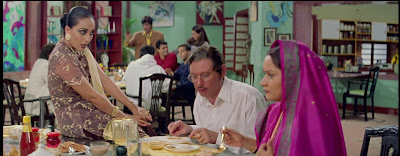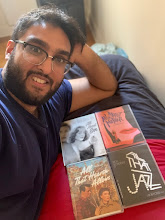The film's main stars are a terrific bunch of actors, all of whom bring different things to the table: Salman Khan, Karisma Kapoor, Saif Ali Khan, Tabu, Sonali Bendre, and Mohnish Behl come from different sides of Bollywood. The three guys are believable as brothers, and the ladies each have their unique personas to give life to their characters. These six actors really dominate the film and their romances and friendships are fun to watch and ultimately heartwarming. Then the film even has a long list of respected character actors including heavyweights like Alok Nath, Reema Lagoo, Neelam, Himani Shivpuri, Satish Kaushak, the late Sadashiv Amrapurkar, Ajit Vachhani, Shakti Kapoor, Mahesh Thakur, and a host of actors from television, regional films and the stage,
The first twenty-five minutes is dedicated to introducing characters. Each character may not be completely developed, but each has his or her own voice. And Barjatya gives each character different relationships with other characters. Some ensemble movies split up their characters into their own little worlds, with little interaction. But Barjatya's ensemble have little, but key, moments where seemingly disparate characters can interact. Take for instance one of Reema Lagoo's friends hitting on Ajit Vachhani or Karisma Kapoor showing Alok Nath her decorations for the party. Not only is Sonali Bendre Salman Khan's love interest, but she's a family friend, she's Satish Kaushak's strict daughter, and intern to Mohnish Behl's doctor. All these characters have reasons for being where they are and for being a part of the film.
By centering his film around an extended family, Barjatya allows for an extended ensemble. The main characters, shown as welcoming, generous, and relatvely happy people, open their doors to all who come to it. That may not be "realistic," but it does feel authentic because each character feels organic to the story. Not only that, but the film allows for even small supporting characters to have small moments--sometimes just an extended close-up--where we can see the scenes through their perspective. Even with huge movie stars like Salman Khan and Karisma Kapoor, Barjatya keeps a steady control over even the minor characters. This is a world that's fully populated, after all.
During the first twenty-five minutes of character introductions, one person is conspicuously missing: Tabu. In the late 1990s, Tabu had already established herself as an critically acclaimed actor with films like Maachis, Hu Tu Tu, and Virasat. Tabu was definitely not a commercial actress, so her inclusion in a big movie like this must have been intriguing. Some of her films were hits, but I'm not sure she was a major box office draw like Madhuri Dixit (to whom the role of Sadhana was originally offered). I say to this because I wonder if anyone in 1999 was wondering how Tabu fit into the film or was waiting for her to show up.
What I like about HSSH is that everyone is doing something. Barjatya's direction keeps the characters involved in the scene, even if they aren't speaking. One thing I like about ensemble movies is what I call "arbitrary dialogue." By that I mean characters in a big crowd scene piping in randomly with lines that could go to anybody. These scenes feel more alive with everyone being involved in the action, rather than just the characters who are the focus of the scene.
Sooraj Barjatya is no stranger to ensembles. But the sprawling but harmonious group of characters and actors he assembles in Hum Saath Saath Hain is next-level. He gives space to his characters, and the actors each get a few moments to shine. Say what you will about HSSH: no story, annoying humor, sexless to the point of priesthood. That Barjatya keeps a steady hand over the extended family is something to be admired.
Like what you read? Please like my blog at Facebook.com/MathurMarquee. Also, follow me on Twitter @HippogriffRider. For more of my work, check out Horror Film Central. Agree? Disagree? Sound off in the comments below!





No comments:
Post a Comment